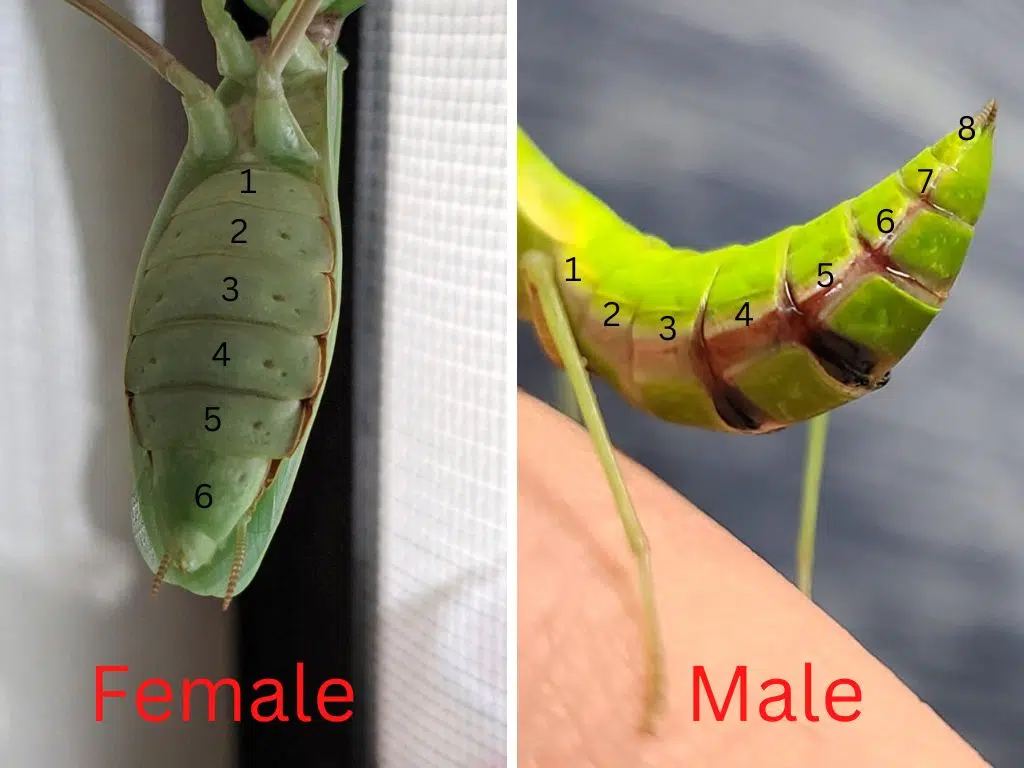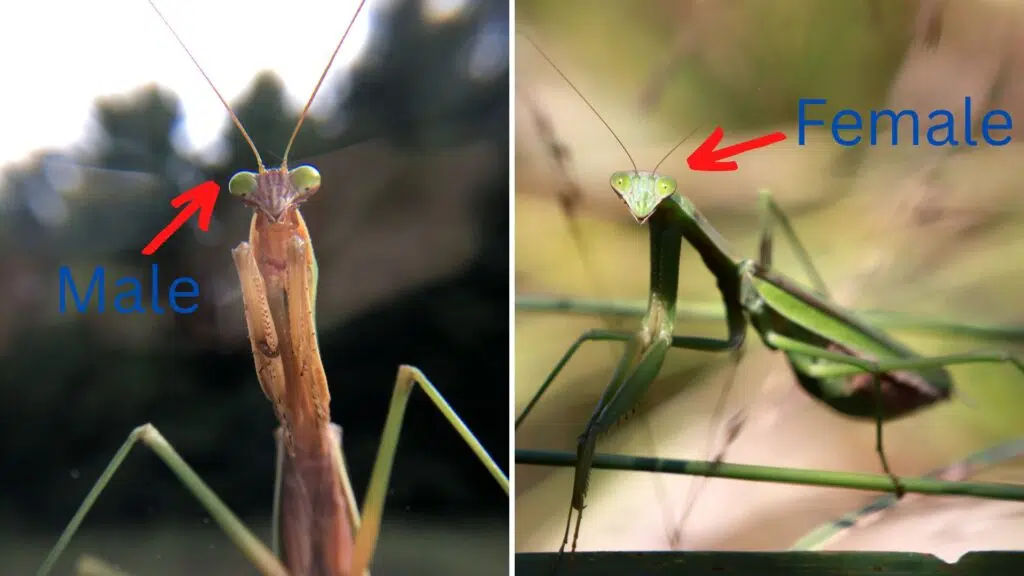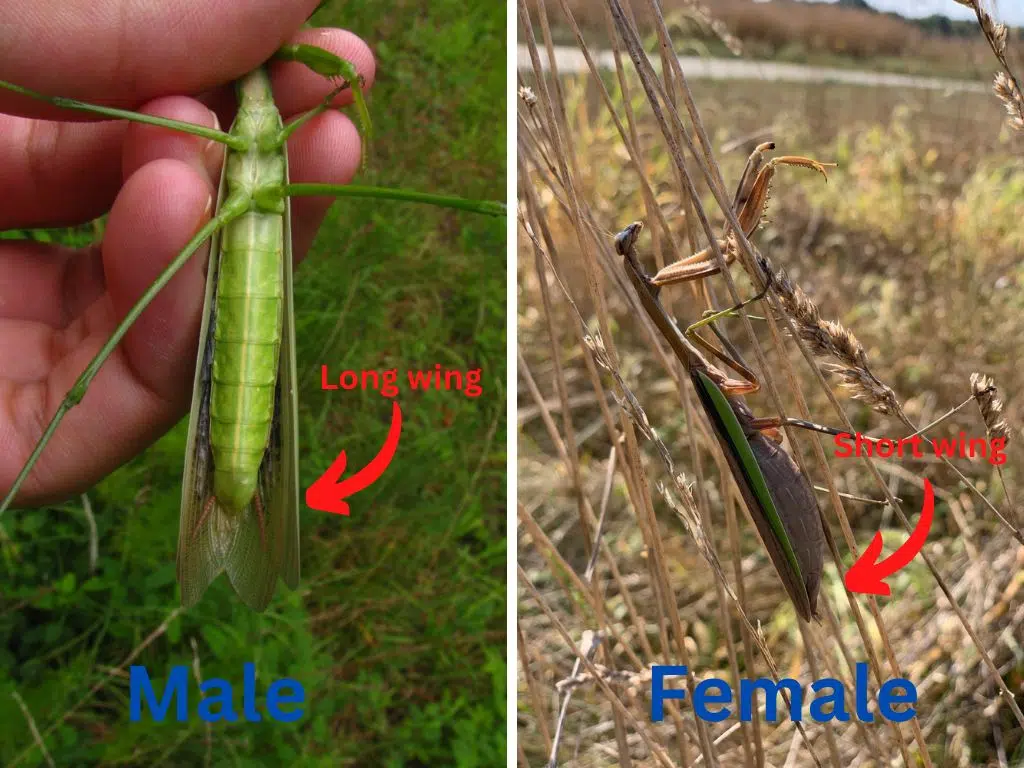Telling the gender of your Praying mantis is important. This is when you know how to name your Praying mantis pet and how to properly house them to avoid cannibalistic behavior.
Gender differences in Praying mantises are not easy to establish. It can even be difficult to establish before the Praying mantis has its first molts.
However, physical gender differences start to become more pronounced in time. These differences become clear as the Praying mantis ages.
Carefully analyzing your Praying mantis will reveal its gender. It’s generally easier to tell the gender of Praying mantis when you have more of them to compare the insects among them.
Table of Contents
Why should you know the gender of your Praying Mantis?
Praying mantises come in male and female genders. There’s a clear separation between the genders that becomes even cleared as these insects age.
While there’s no exact age when telling the gender is easier since there are so many types of Praying mantises, it’s generally wise to wait for a few molts before clearly establishing the gender of a Praying mantis. Here’s why this is important.
Naming
The name of a Praying mantis is generally tied to its gender. While genderless pet names are common, many people prefer to give them a gender-specific name. This is not possible as soon as Praying mantises are born.
Diet
Females are responsible for carrying and laying eggs in the Praying mantis species. This means females should eat more than males as they need more energy during the mating process.
A female Praying mantis lays at least 40 eggs. Females can lay as many as 400 fertilized eggs which means their caloric consumption is higher.
Flying
The Praying mantis is an interesting species where males alone can fly. This means the Praying mantis female cannot fly at all.
Handling your Praying mantis should be done with care, as a result, especially if your insect is male. Since females can’t fly, they are easier to maneuver outside their enclose without a flying away risk.
Breeding
Breeding needs are important in Praying mantises. Females are known to lay eggs in different locations. This includes any items available in the enclosure as well as walls.
Loose leaves are also a good location for females to lay eggs in. You know how to provide these nesting places for your Praying mantis only when you’re sure your insect is a female.
Communal habitat
The most important reason to determine the gender of your Praying mantis is sexual cannibalism, especially when you have multiple insects living together in the same enclosure.
The female Praying mantis is known for eating the male Praying mantis after mating. It’s believed this tactic is tied to the survival rates of the female and the eggs.
You might try to counteract sexual cannibalism by feeding your Praying mantises more. However, this doesn’t always guarantee the female won’t eat the male Praying mantis.
How old does a Praying mantis need to be to tell its gender?
A Praying mantis needs at least 7 molts to become an adult. It can sometimes take 9 molts for a Praying mantis to become a full adult.
Telling the gender of your Praying mantis should not take that long. You can mostly tell its gender after the 3rd or 4th molt.
Ways to identify the gender
There are various ways in which you can tell the gender of your Praying mantis. Looking at size differences between males and females helps. Antennas and even the length of the wings can all be variables that tell you the difference between male and female Praying mantises.
Segment counting
The number of segments in the body of a Praying mantis has differed from males to females.
Female Praying mantises have 6 abdominal segments you can count easily. Male Praying mantises have 8 abdominal segments.

The size of the segments
The size of the segments is just as important as their numbers. While males have more segments female Praying mantises have wider segments.
This is best seen in the final segment on the abdomen of the female which is considerably wider than the final segment on the male’s abdomen.
As the name suggests, these segments are only visible on the abdomen. You won’t see any segments on the back of your Praying mantis. Turning the insect over is recommended so you can count the number of the abdomen segments.
Antennae

Antennae might look similar both on males and females but are different.
The problem with comparing antennae is that you have to wait for at least the 3rd molt to tell the difference. However, it should be easy to compare antennae once your Praying mantis has molted the 4th time.
Males have considerably wider antennae than female Praying mantises. Male antennae are also considerably longer.
By comparison, female Praying mantis antennae looks fragile, almost similar to needles in their thin profile.
Body size
Body size alone might not be sufficient to determine which Praying mantis is male and which is female.
There are a few species such as Macromantis where this can be the case. Males are smaller than females for this species.
Macromantis, just as other species of Praying mantis are known to exhibit sexual dimorphism. This includes a wider array of differences between males and females which include the size of the individuals.
In the case of many Praying mantis species, sexual dimorphism is severe. Females start to outgrow males at an early stage. Males never catch up in body size to the females.
Body type
Sexual dimorphism in Praying mantises also manifests itself in the actual thickness of the body in the thorax. This is where further differences arise between males and females.
Many types of female Praying mantises have wider thoraxes compared to males. They exhibit a more robust body in adulthood. Males remain thinner or not as robust compared to females at all stages of their lives.
Length of the wings

Male Praying mantises have longer wings compared to females. Their wings expand past their body or they are at least as long as the body itself.
Female Praying mantises have shorter wings. These wings are known to be shorter than the wings of males but only realistically comparable in length when the female becomes an adult.
It’s believed male Praying mantises have longer wings as they need to fly more. Finding a prospective mate is one of the reasons males might have longer wings than females.
The combination of a narrower thorax, a small body, and larger wings make the male Praying mantis good at flying as opposed to the female.
Eyes
The male Praying mantis is known to have larger eyes than the female. It’s not known if this physical trait is an adaptation for mating, but scientists show males tend to have larger eyes and eyes that are facing forward.
The forward-facing ocelli of male Praying mantises might be unusual in the world of insects. But larger eyes in males might make them see better than females. Their capacity to fly might be an explanation for why males have adapted to larger eyes.
Agility
A smaller body makes males more agile. Those raising Praying mantises at home should know males might need a larger container since they tend to move around more.
Some female Praying mantises are so large they can’t even fly. With reduced agility, females might not need as large of a container as males.
Cannibalism
One of the distinct methods of telling a difference between a male and a female is found in cannibalistic behavior.
Many species of Praying mantises show distinct types of cannibalistic behavior, but only in females.
The female might eat the male at the end of the mating process. This is almost always preceded by a fight between the male and the female. The female is stronger with a larger body which means males are frequently eaten by females.
This cannibalistic behavior means you might have to separate the female from other males whenever you raise them in captivity. It’s not unusual for the female to kill more males after mating with them.
Camouflage
Praying mantises are very good at hiding in plain sight through camouflage. There’s growing evidence to support the idea that males and females might retain different camouflage coloring as they become adults within the same species.
For example, Latin American Praying Mantises are known to have different camouflage coloring from males to females.
As the species grows and matures from nymphs this coloring becomes more visible. Males retain the same brown-shade camouflage coloring and a narrower body.
The female will grow larger and develop into a green color that mimics a leaf.
This unique trait is believed to be an evolutionary trait of insects. Convergent evolution is the process where males and females might develop differently even when they live in the same environment.
Summary
Male and female Praying mantises rarely look similar. Apart from the males having the ability to fly, there are other differences that might make for easy identification between the genders.
Males are known to have longer wings, mainly to support their flying needs for breeding purposes. Females have larger bodies, mainly to support their capacity to lay eggs. Females are also known for having 2 more abdominal segments compared to males.
Further Reading: